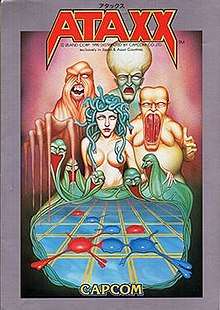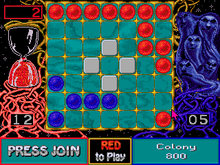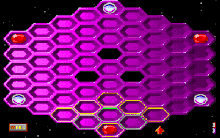Ataxx
Ataxx (アタックス) is a strategy video game that was published in arcades by The Leland Corporation in 1990. It also appeared the same year as Spot: The Video Game and later as the Microscope Puzzle from the 1993 CD-ROM game The 7th Guest. The game was invented by Dave Crummack and Craig Galley in 1988 and was originally called Infection. It was first programmed on Amiga, Commodore 64, and Atari ST.
| Ataxx | |
|---|---|
 Japanese arcade flyer | |
| Publisher(s) | Capcom The Leland Corporation |
| Platform(s) | Arcade |
| Release | 1990 |
| Genre(s) | Strategy |
| Mode(s) | Single-player, Multiplayer |
Although Ataxx was sold as a video game and not with a physical game board, it can be played with a Reversi set.[1]
Gameplay
Ataxx is an abstract strategy board game that involves play by two parties on a seven-by-seven square grid. The object of the game is for the player to make pieces constitute a majority of the pieces on the board at the end of the game, by converting as many of their opponent's pieces as possible.

Each player begins with two pieces, white and black, for the first player and second player respectively. The game starts with the four pieces on the four corners of the board, with white in the top left and bottom right and black on the other two. White moves first.
During their turn, players move one of their pieces either one or two spaces in any direction. Diagonal distances are equivalent to orthogonal distances, i.e. it is legal to move to a square whose relative position is two squares away both vertically and horizontally. If the destination is adjacent to the source, a new piece is created on the empty departure square. Otherwise the piece on the source moves to the destination. After the move, all of the opponent player's pieces adjacent to the destination square are converted to the color of the moving player. Players must move unless no legal move is possible, in which case they must pass.
The board configuration may be altered by having certain squares filled (not playable by either player), or using different board sizes.
The game ends when all squares have been filled or one of the players has no remaining pieces. The player with the most pieces wins. A draw may occur when the number of squares is even, either from non-playable squares or nonstandard sizes having an even number of squares. Some versions also implement the threefold repetition rule from chess.
Variations
The arcade version is timed, similarly to blitz chess. Each player's timer counts down while it is their turn to move; they lose if it reaches zero, but may buy more time (100 seconds per quarter) while the game is in progress. After completing a game (whether they won or lost), a player may choose whether or not to play another game with the time remaining.
History
Originally called Infection, the game was invented by Dave Crummack and Craig Galley in 1988 for Wise Owl Software, which then sold the rights to Virgin Mastertronic UK. Although versions of Infection were programmed for Amiga, Commodore 64, and Atari ST, none saw a commercial release. Eventually, the game was picked up by Virgin Mastertronic US, which licensed it to the Leland corporation, who then released it as the arcade game Ataxx in 1990. Around the same time, Virgin released its own version of the game, Spot for NES, PC, and Game Boy, based on Cool Spot, a character from a 7 Up marketing campaign of the time.[2]
In 1993, Virgin released the Trilobyte-produced game The 7th Guest, which contained a version of Ataxx as its Microscope Puzzle. Graeme Devine of Trilobyte, co-creator of The 7th Guest, had overseen the production of Spot while working at Virgin.[2] The Microscope Puzzle is one of the most popular versions of Ataxx. The player faces off with the AI in the game, in this case the antagonist "Stauf", who is incredibly difficult to beat—all the while laughing and ridiculing the player with phrases like "Ooooooooo Baaaaaaaad Mooooooooove," and "We'll all be dead by the time you solve this!" If the player makes a particularly successful move, Stauf yells "Curses!" The pieces were seen through a microscope on a slide, interpreted as bacterial cells, two sets blue and two sets green. Passing over this puzzle in the game requires two trips to the library to the hint book. In April 2011, an updated version of the Microscope Puzzle was released as a stand-alone app for iPad under the title The 7th Guest: Infection.
The sequel to The 7th Guest, The 11th Hour, also features a version of Ataxx, but with a hexagonal board.
Reception
Legacy

One Ataxx clone was Boogers, an online 4-player version hosted by the ImagiNation Network, a pre-internet dial-up game network. Two to four players fought on a large board (9×9).
Ataxx Arcade is an iPhone version that attempts to recreate some of the atmosphere of the original arcade game. It has 5 opponents: Colony, Droolman, Mushman, Medusa, and Cephalo; and 40 levels in its current version. The AI uses a min/max alpha beta pruning strategy, with Medusa employing a 1-player search and Cephalo employing a 2-player search, which most players find difficult to beat.
The Sierra educational title Mega Math included a clone of Ataxx where the player must answer math questions in order to move.
Buzzlabs has a freeware version called Aquataxx for Mac OS X, written in the Java language with Apple's Cocoa Frameworks. It has online chat and network play.
Green Thumb is a variant for the iPhone that turns the game into more of a puzzle-style game with over 50 different boards to try to solve.
Kloon! is a freeware variant that adds several different options to the game, such as obstacles and random "misclones", which don't capture any opponent pieces.
The 1998 eGames variant Blobs uses the Zillions Development Engine and allows for choosing different boards with obstacles.
Hexxagōn [3] is a variant of Ataxx that is played on a hexagonal board instead of a square one. It was released as a PC game in 1993 by Software Creations (US).[4]
The 7th Guest: Infection is another clone. Kansen is a game for iOS and Android devices that similar to Ataxx and Hexxagon.
References
- Ataxx page at BoardGameGeek
- Ataxx origins at Pressibus
- Hexxagōn online game
- Miller, Chuck (December 1993). "Stocking Up On Holiday Joy With Our Holiday Shareware Picks". Computer Gaming World. pp. 86, 88. Retrieved 29 March 2016.